David Appleyard is a versatile creative practitioner working from his studio in Sheffield. He creates works that take the form of sculptures, architectural interventions, time-based works, and engagement activities involving local communities, using various materials and processes including timber, metal, glass, stone, resin, light, and sound.
David’s work encompasses both studio projects and site-specific installations for public and private commissions, many of which are inspired by aspects of heritage. His practice is diverse and rooted in research-driven methods, often involving collaborations to share and discuss ideas within communities. A key aspect of his work is storytelling through objects and installations, which convey historical narratives, a sense of humour, and reflections on our place in the world, effectively capturing our collective heritage and human experience.
Court Spencer caught up with him to hear about his latest projects and what he’s working on.
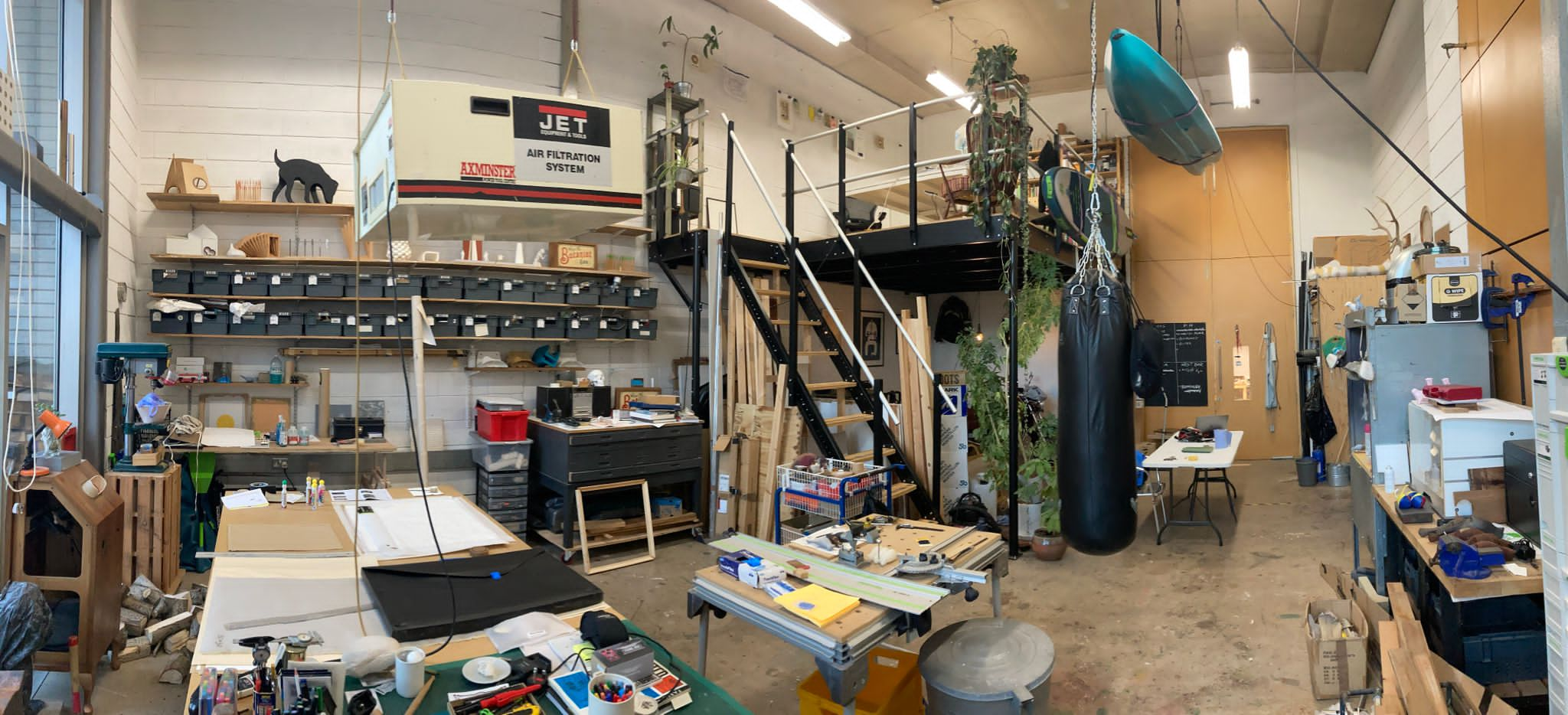
Studio with mezzanine.
Court: Thank you so much for being part of the column. Your studio is fab! Perhaps it’s best to begin with that. How long have you been here? And can you tell us about that fabulous mezzanine which makes good use of the exceptionally high ceilings?
David: I’ve been a studio holder here at Yorkshire Artspace for over 15 years. Originally, I was on the floor above but when this space became available, I jumped at the chance of moving into a bigger more versatile environment. I’ve used the space well and have taken advantage of the ceiling height by building larger work, and, as you mentioned, I’ve recently constructed a mezzanine which allows me to keep a clean space above the workshop.
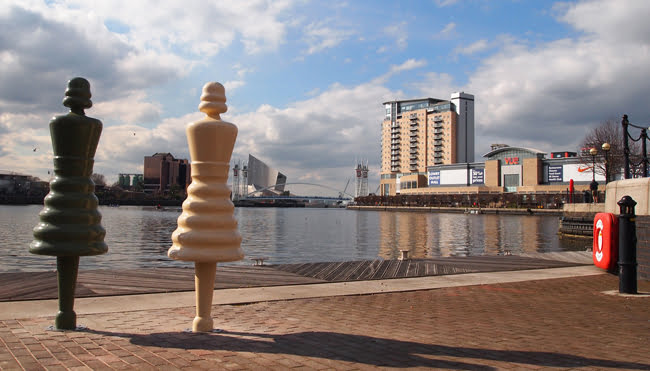
Factory Girls at Salford Quays, Salford. Photo by Ben Blacknell.
Court: It’s an incredible place to be based. I know most of your projects are very collaborative and not necessarily something you could deliver alone. Do you collaborate with other studio holders here?
David: Absolutely! A number of the projects have been completed in collaboration with fellow YAS studio holders including Darren Richardson aka Daz and Anthony Bennett to name a couple. Darren’s studio is on the other side of the atrium to mine and Ant is on the next floor up so it’s extremely handy. A group of us are also in the process of launching a gallery project.
Court: I’m always interested in a gallery project! Can you say a little more about that?
David: Yeah, it’s a bit of an experiment really. A friend and I wanted to find an approach that gave us the autonomy to present the sort of exhibitions we really wanted to see happen. The Good Ship Presents is a floating gallery affiliated with Yorkshire Artspace. For the first two shows, we’re docked at Persistence Works but we hope to sail to new horizons when the winds favour us.
I’m really excited to be showing the work of Paul Housley. He’s a painter who I’ve admired for ages and he studied in Sheffield in the 1980s so that’s nice to be able to bring him back here. Working with Paul and exploring his London studio has been a remarkable experience, one that has greatly enriched my appreciation and understanding of his paintings.
Court: That sounds incredible! When’s the show?
David: The show’s called: ‘A Playground in the Factory’ and the opening is on Thursday 9 Nov, 6:30-9:30pm at Persistence Works (21 Brown Street, Sheffield S1 2BS). All are welcome! It will be open from the 10th November to the 2nd December (11am-4pm on Thursday – Saturday).
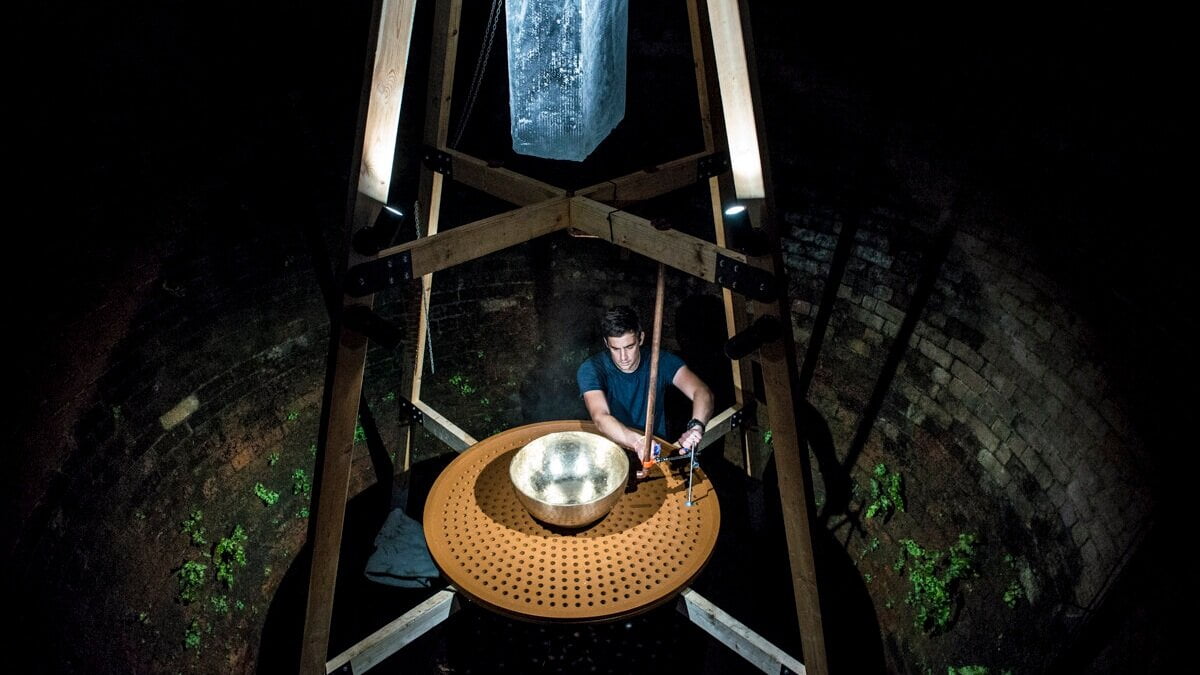
David Appleyard installing Time in the Ice-House. (Photo credit: Jonathan Turner)
Court: The first time I came across your work was back in 2018 when you were talking at a conference about your project Time in the Ice-House at Norton Priory Museum and Gardens. Could you tell us a bit about that commission and your approach to the project?
David: That commission was part of the Arts and Heritage, Meeting Point 2 project. It was a completely different commissioning process to what I had experienced before. It started with an event held up at The Baltic where various museums gave presentations about their aspirations for their projects. There were a lot of artists in attendance, and we were all invited to apply for up to three projects and I managed to get shortlisted for all three of the commissions I applied for, and eventually won two of the projects! I was only able to choose one, so I decided to partner with Norton Priory Museum and Gardens.
It was a fantastic experience, helped by a very accommodating team at the Museum. I’ve always been fascinated by the various ways time was measured in the middle ages; from beeswax candles and water clocks to sundials and our very own body clocks. All were commonly used in monastic communities to ensure the set daily cycle of prayer. Time keeping and the history of the ice house within the walled garden really formed the basis of my idea to mark the passing of time through the slowly melting ice and the chiming of a singing bowl.
Court: You were offered two projects! That’s fab! Can you tell us how you became an artist?
David: After A-Levels I enrolled on a Foundation Course at Bradford and Ilkley Community College. This was by far the best part of my education and it was here that I developed a passion for painting and sculpture, however, for one reason or another I went on to study Industrial Design. Looking back I always knew that I was on the wrong course and that a traditional career in industrial design was not for me. I did work for a design consultancy for a couple of years followed by a few years working as a researcher at Sheffield Hallam University.
As part of my work within the research department also I completed an MA in Design. I used this as an opportunity to explore how my background in design could be used to make a side-step into a sculpture practice. That was back in 2006 and the work on my website shows some of the projects that I’ve been involved with since then. Things feel like they’re changing slightly again, I’ve got a really strong desire to start making more of my own work, including painting and prints as well as smaller scale sculpture.
Court: You work across a range of self-initiated projects and responses to client briefs. What’s the process for commissions? Do you always respond to a brief or do you make speculative approaches?
David: The commissions are usually open calls where I send an expression of interest and keep my fingers crossed! Some you win and some you don’t. I also get the odd request for work. Most projects for the public realm are completely driven by a brief and the research I conduct about specific sites. I really enjoy teasing out research and the weaving of narratives. This approach has worked so far but as time goes on I seem to be accumulating a lot of unrealised ideas which could have the potential to be delivered elsewhere and in different mediums.
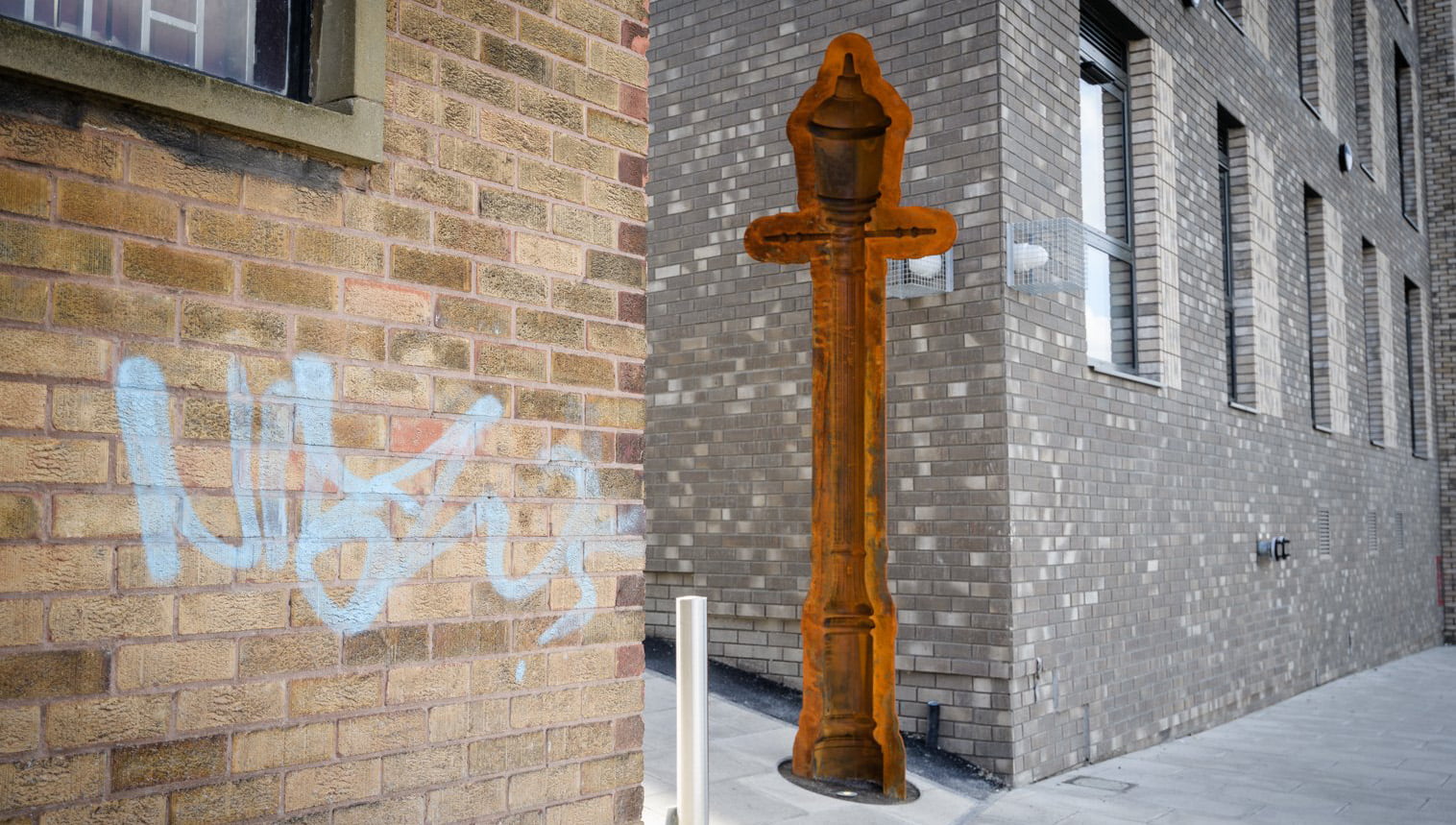
What a Stinker! On Scotland Street, Sheffield. (Photo credit: Mark Howe)
Court: That’s a really nice way to look at unrealised projects, that they just haven’t found the right setting yet. You’ve recently launched What a Stinker! A 4m high cast iron sculpture on Scotland Street in Sheffield. Could you tell us a bit about this project and what instigated the response to present the negative impression of a streetlight in this way?
David: It was all about George Orwell and his time in Sheffield researching for his book ‘The Road to Wigan Pier’. At first glance, Orwell’s descriptions of Sheffield and the industrial filth he found etched into the city walls are really negative. However, his descriptions also used colour and references to ‘streetlamps, twinkling like stars’ to describe what he could see.
I really liked how even whilst walking through smog filled streets he could find beautiful ways to describe the negatives. Coupled with that were the gas destructor lamps that had been installed in Sheffield between 1914 and 1935. Possibly some of the ‘twinkling stars’ he saw. Like Orwell’s descriptive text, the lamps took the accumulating dangerous sewer gas (a negative) and made a positive light.
Court: Your projects really are very varied. It feels like you make whatever feels right for the space or project, rather than having a set style that you impose. Is that a fair comment?
David: That’s fair, yes. It used to really bother me that I didn’t have a particular style or direction, in some ways it still does. The issue I have is that every brief is unique, as are the places where I’ve worked. To impose a particular style or material just because of a personal preference has never sat well with me. Some artists do and that’s fine, but my preference is to tackle each project as a blank canvas.
As for a style or a particular type of practice, I think it’s something that I’ll always be chasing, but only within the confines of my studio work.
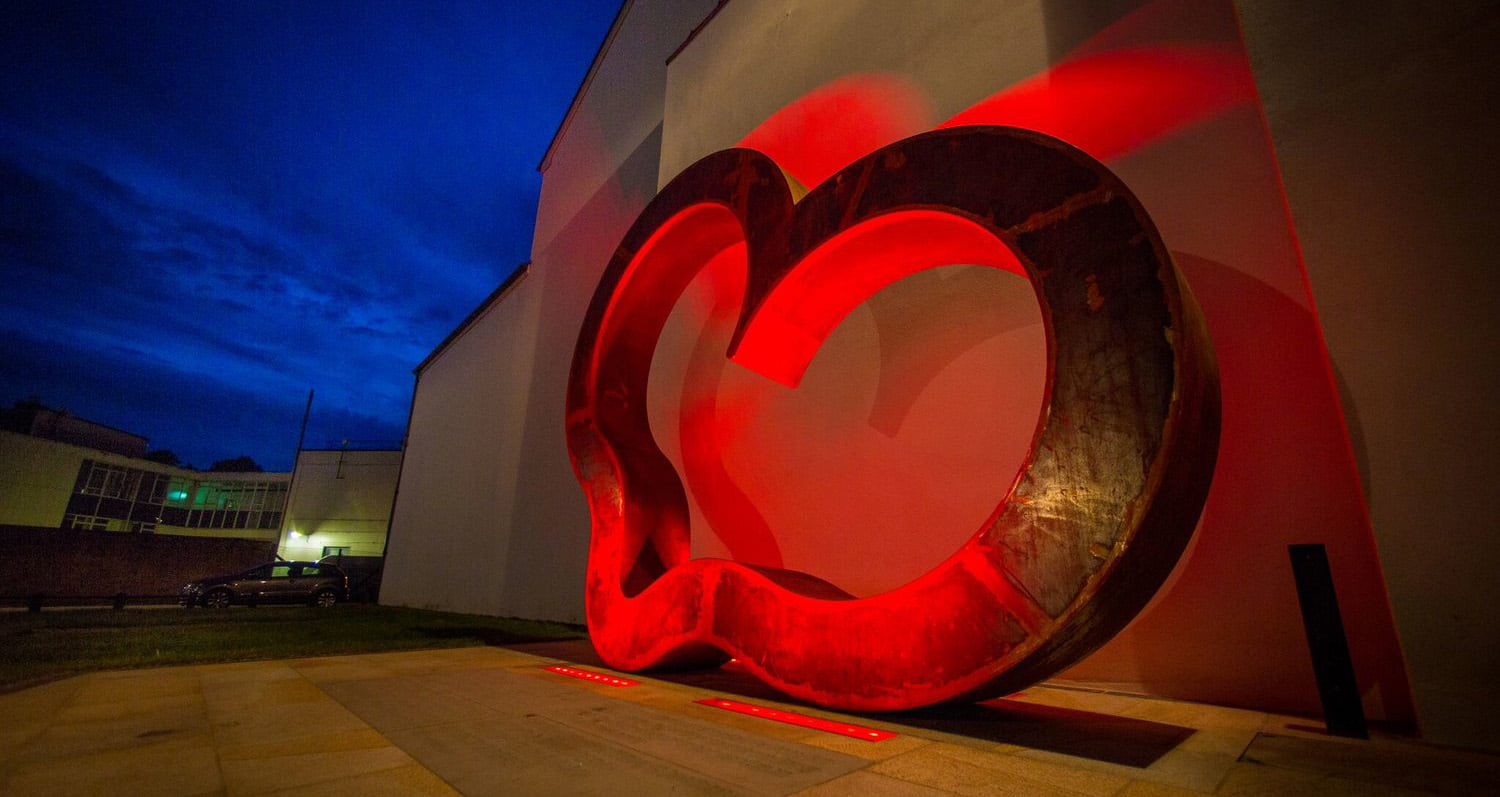
Merthyr Tydfil Has An Iron Heart. (Photo credit: Richard Jones / MLA Photography)
Court: You’ve worked on some incredible projects. What would be your career highlight to date?
David: Without hesitation, the project I did in 2017 for Merthyr was a fantastic experience from start to finish. The people in Merthyr made the project what it is. Merthyr Tydfil Has An Iron Heart is a large iron heart that’s leaning against a building in the centre of the town. The piece is intended as a symbol of love and strength, two qualities which for me (as a visitor), summarise the feelings I developed towards the Welsh Valleys town.
I commissioned the poet Gillian Clarke to write a bi-lingual poem. It has three verses in English and concludes with a Welsh englyn that has all been letter-cut across large sandstone slabs in front of the sculpture. At various points in history, Merthyr Tydfil’s heart could have been broken but this hasn’t happened. The sculpture celebrates the town’s strength and its ability to re-imagine, re-develop and above all stand tall.
Court: That sounds like such a lovely project to work on. Do you have a dream project that you would love the opportunity to make a reality?
David: I’ve got a long list of unrealised projects that include sculpture, paintings and prints. If I had the time and finance I would like to start working through the list to develop a body of work to show.
Court: Yeah, I can imagine one project sparks a dozen more! What are you working on at the moment?
David: I’m working on a public art project for a space in Battersea which explores the pioneering work of the Short brothers and Charles Rolls. I’m also curating the Paul Housley show in Sheffield that opens on the 9th November and runs until 3 December.
Court: I’m really looking forward to seeing that show. What’s the best way for people to keep an eye on your work?
Court: David, thank you so much for your time. I really do love the blend of art, design and wit that you bring to your work. And I very much look forward to seeing your upcoming projects and more from The Good Ship Presents.
Filed under: Art & Photography
Tagged with: art, artist, column, community, creativity, history, humour, installations, interview, projects, sculpture, Sheffield, site-specific, Studio, traditional, yorkshire
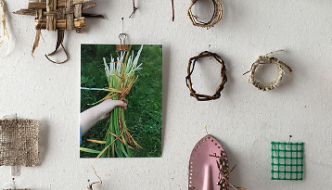

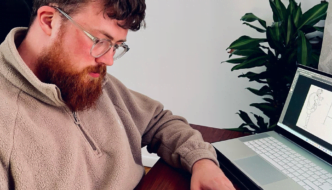
Comments